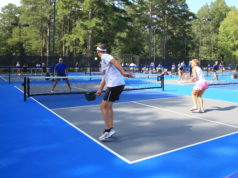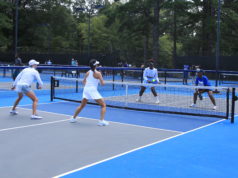By Christopher Hagman, President of Atlantic Recreation
In working with people starting in the tennis industry, new coaches and established pros, it is important to know how much they know about doubles tactics and strategies. After all, most recreational team coaching is about doubles! And, players win and have more fun with a coach who truly knows what he or she is talking about. Here are some questions to assess general doubles knowledge. Doubles IQ is a useful tool for a variety of people connected to tennis, and there are objective answers grounded in sports science.
1. Your team is facing an excellent server. Most returns you’ve gotten back have been aggressively volleyed and won by the server’s partner. What should you do? Play two back when returning a serve. This will give you considerably more time and distance to defend the aggressive volley. Many top teams play two back on the first serve then move to one up and one back on the second serve.
2. You and your partner are both at the baseline and you are about to hit the next shot. Who on your team should decide to approach the net or stay back? You should decide because the hitter leads the team. Hit your shot and move to a home base (up or back). This is your partner’s cue to follow and stay together.
3. Upon deciding to poach, at what time should you move? Move when your opponent starts her forward swing. Even if she sees you move, it is difficult to change direction and still make the shot.
4. Describe your forward movement and how far from the net should you be for your first volley? Serve and keep moving forward and split step (get balanced) right before your opponent makes contact. Strive to be inside the service line for your first volley.
5. What type of spin should you hit? Underspin. Doubles is played and won at the net, and underspin is best for most volleys.
6. Where is your best shot when your opponents are at the net and your team is one up and one back, and the ball comes to you at the baseline? When your team is one up and one back and the ball is to you at the baseline, keep the ball in front of your partner. Hence, the best shot is a low cross-court drive, as this is the only shot in which your partner is not vulnerable for being attacked.
7. Where is your best approach shot when your opponents are at the net and your team is approaching the net? Low to the “T” (intersection of the center service line and service line). This directs the ball over the lowest part of the net, and even if your opponents cover the approach shot, you now have an open side for your next volley.
_______
Hagman is a former AA1 city champion, GPTA doubles champion and USTA player development coach. Learn more about Atlantic Recreation by visiting atlrec.net.




